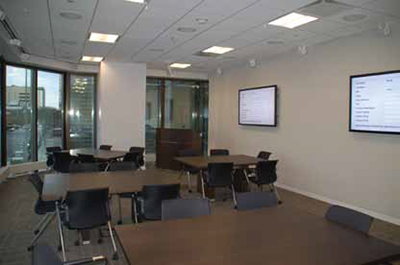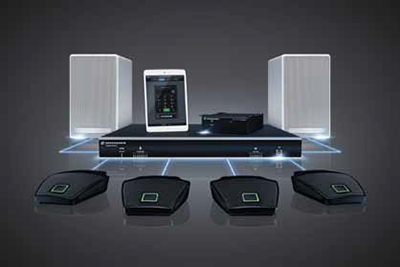Collaborate with Clarity: Audio and Collaboration

If You Can’t Hear, How Can You Work Together?
“Can you hear me now?” It’s irksome enough to have to say it during a one-on-one cell phone call—but in the weekly videoconference, with 40 people in your room, and another big group on the opposite coast? It’s a stone-cold communications killer.
Calgary-based energy company Enbridge installed a Meyer Sound Constellation acoustic system in order to clarify corporate communication and facilitating the free flow of ideas. In environments where speech communication is essential, the voice lift feature of Constellation enhances speech intelligibility by generating precisely articulated and directed early reflections. Audio collaboration has advanced: sonic lapses may once have been accepted as part of the telepresence experience, but no longer. Sound is expected to be 100-percent crisp, clear, and highly intelligible for all parties, from the moment a meeting kicks in—and for good reason.
“Audio plays the most important role in the successful transmission of information during a conference,” said Vanessa Jensen, senior product specialist of integrated systems for Sennheiser. “The video aspect will provide cues, but is secondary to the audio content. Both video and audio are integral components of any telepresence experience— however, video without audio is simply silent picture.”
“Good audio is crucial,” agreed Gene Houck, national sales manager of installed sound for Audix. “Since telepresence is a two—or more— way information sharing process which involves one party sending a message that is easily understood by a receiving party, telepresence’s effectiveness is dependent on good fidelity.”
But signal quality itself is only one area in which the bar for audio collaboration has been raised—simplicity is expected as well. “Users want the technology to get out of the way,” said Bill Schuermann, senior design consultant for Houston, TX -based SLR International Corporation. “Clients are looking for systems where the presenter can walk in, and all they have to do is plug in their laptop. Everything else should be automatic.”

Sennheiser TeamConnect is an end-to-end meeting solution that is simple to install and use, while featuring outstanding sound quality at a reasonable price point. The system integrates speakers, mics, a central control unit, and connectivity management—everything needed to handle meeting rooms with up to 16 users on site. Schuermann pointed to SLR’s use of Meyer Sound’s Constellation— an integrated, turnkey acoustic solution—in a new corporate learning center for Enbridge, the Calgary, Alberta, Canada-based energy company, as an example of a comprehensive solution. “Constellation helped us meet the client’s objectives on multiple fronts: Ease of use, quality of audio in room, quality of audio experience at the far end, and of what’s being brought in from there to the point of origination. To be successful at that takes great equipment and great AV design, but it also takes a great acoustical design. The best telepresence system put into a room with lousy acoustics is a waste of money.”
A daily selection of the top stories for AV integrators, resellers and consultants. Sign up below.
Microphone choice is obviously critical in setting the pace for a collaborative environment’s success or failure. “AV clients do not want to be encumbered by microphones,” noted Audix’s Houck. “They want to be able to go about their business without thinking about where a microphone is, what direction they need to speak or having to be careful not to cover up a mic with a laptop or papers.
“Users also began utilizing rooms for multiple meeting and training purposes via flex seating,” Houck continued. “At Audix we saw these developments as an opportunity to bring new design and innovation into a series of high output ceiling microphone offerings that are able to fit into a variety of room applications. Advances in DSP technology have been effective in minimizing room noise and cancelling out echo, resulting in more effective use of ceiling microphones.”
The ongoing demand for simplicity in design and solutions brought about the concept of a trielement hanging microphone in the AV world, filling the need for a mic that is a single source with broad coverage, and also easy to install. In response, Audix introduced their new M3 trielement microphone at InfoComm 2014. “The M3 is the only multi-element design available with fully balanced circuits below the ceiling and a UL -rated plenum box solution above the ceiling tile,” said Houck. “The low impedance design of the M3 system allows for extremely long cable runs—if required—without cross talk or interference. Evenly dispersed sound with undetectable phase and a sleek contemporary design set this microphone apart.”
Microphone specialists Sennheiser build on their place in the environment with integrated systems like the TeamConnect all-in-one audio conferencing solution, their Speechline microphones, and their ADN Wired and Wireless Discussion Systems, which are specifically designed to further collaboration.
“In many instances, customers are moving toward configurable collaboration spaces as opposed to the fixed architectures of the past,” explained Sennheiser’s Jensen of the impact on wireless systems on the collaborative vertical. “In these cases, wireless conferencing/collaboration products make the most sense. Manufacturers are currently trying to innovate solutions that sound good, provide enough talk time, distance, and channel count to effectively compete in this market. There are currently a variety of differing technologies in this space including: Radio Frequency, Infra- Red, and DECT to name a few.”
Of course, the technology isn’t the only thing that’s changing. The spaces themselves are evolving, with huddle rooms emerging fast. “Smart integrators are including huddle rooms in their conferencing design package,” Houck stated. “Audio quality often gets overlooked in a huddle room atmosphere. Some believe that the audio quality does not have to be much better than the iPhones used to share information. There is also the perception that a USB microphone needs to be incorporated.
“There are, however, many gain-sharing mixers available that offer USB outputs and allow the user to avoid needing to begin the audio link with a USB mic, and instead utilize a higher quality condenser room or table mic. Good audio quality can enhance the huddle room experience the same way it does a larger conference room.”
To steer their clients to the best possible telepresence experience, AV integrators will ideally be able to influence the room’s design from the ground up. “No matter how much we—or other manufacturers—are able to innovate our audio products, we all are still bound by the physics of audio,” said Vanessa Jensen. “To that end, a room that was designed for aesthetics, typically with lots of glass and other hard surfaces, is always going to be an adversary to quality audio. Integrators can continue to stress the importance to clients and architects that proper design for audio in a collaboration space begins with the dimensions of the space itself and proceeds through the materials used.”
While an evolving marketplace can present tempting cost savings to clients in the form of software and cloud-based video collaboration tools, Audix’ Gene Houck sees expansive opportunity for integrators in the telepresence space.
“For the highest quality performance and environmental control, the higher end solution of a hardware-based video conferencing system will still be the way to go,” he said. “Larger conference rooms will require integrated system installation. The exciting part of the AV/IT convergence is that there will be many opportunities for integrators to incorporate the best and most cutting edge products of both worlds on the same job.”
David Weiss (www.dwords.com) writes extensively about AV, audio, and broadcast technology.
Meyer Sound Constellation Fosters Idea Sharing
Calgary-based energy company Enbridge is the latest corporation to install a Meyer Sound Constellation acoustic system, with the goal of clarifying corporate communication and facilitating the free flow of ideas. Eliminating the need for lavalier or handheld microphones, the systems support a variety of functions in two adjacent meeting rooms located in the company’s new Learning Center. The systems are part of a complete AV design by Bill Schuermann, senior consultant at the Houston office of SLR Consulting.
“The rooms are used for everything from executive meetings, teleconferencing, and employee training, to safety orientations for construction workers, and even occasional social events,” said Amin Ladha, AV subject matter expert at Enbridge. “Constellation has performed exceptionally well for all of them.”
Constellation is an active approach to expanding the acoustic capabilities of a multipurpose space. In environments where speech communication is essential, the voice lift feature of Constellation enhances speech intelligibility by generating precisely articulated and directed early reflections.
In Learning Center A at Enbridge, the system is equipped with three preset modes to take advantage of the voice lift feature. For presentations, the system picks up signals near the presenter and reproduces them in the audience area. In Conference Table mode, the system focuses on sounds from the center of the room, and Small Groups mode uses subtle reverberation effects to provide acoustical isolation between adjacent groups.
“Learning Center A is a large room, and several important staff members are very soft-spoken,” said Ladha. “If that person is at one end of the room, he or she could not be heard at the other end without Constellation turned on. But when it’s on, they can talk in a natural tone of voice, and everybody hears clearly at the other end, even though the voice stays localized in place. It sounds like the person is five feet away rather than 50.”
Worldwide partners connecting with Enbridge via teleconferencing have also noticed the improvements in intelligibility. “We used to have people at the other end complain that it sounded like we were in a tunnel,” reported Ladha. “In the new rooms, that is all eliminated.”
The system in Learning Center A comprises 66 MM-4XP self-powered loudspeakers and six MM-10XP subwoofers, both with IntelligentDC technology, and 24 miniature condenser microphones tucked close to the ceiling. Learning Center B has a similar setup, employing 30 MM-4XP loudspeakers, two MM-10XP subwoofers, and eight microphones. A D-Mitri digital audio platform with the patented VRAS acoustical algorithm is at the core of both systems.
Ladha was also pleased to discover that, since the new systems have been installed, requests coming to him for technical support to solve audio problems have dropped by about 75 percent.
“These are multi-purpose rooms, and Constellation’s voice lift technology is in use constantly,” said Ladha. “It’s easy to use, highly effective, and is proving exceptionally useful. Before Constellation, people in the back were asked to stand and talk louder. Now, people can stay focused on the conversation.”
In addition, the Learning Center has equipped its small meeting room and two social areas with 39 Stella-8C installation loudspeakers and three MM-10XP subwoofers.
Other technologies housed in the Learning Center include Biamp Tesira audio DSP and routing, NEC and Sharp video screens, and a Crestron DigitalMedia system. All systems were installed by the Calgary office of AVISPL, with project management by Chad Lavoie.
